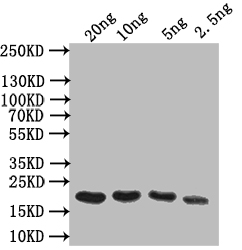The production of the odorant-binding protein polyclonal antibody commences with the selection of a recombinant Bos taurus odorant-binding protein fragment (comprising amino acids 1 to 159) as the immunogen. This fragment is employed to immunize a rabbit, inducing an antibody response. Subsequently, serum is collected from the rabbit to obtain polyclonal antibodies. These antibodies are then purified through affinity chromatography. The odorant-binding antibody's functional utility is assessed in ELISA and WB assays, confirming its efficacy in detecting Bos taurus odorant-binding protein.
The Bos taurus odorant-binding protein (OBP) is involved in oder detection and recognition, sensory perception, and chemical communication including finding food, detecting predators, and social communication. OBPs bind and transport odorant molecules from the environment to the olfactory receptors in the sensory neurons of the nasal epithelium, aiding in the transmission of olfactory signals to the brain, where they are processed and interpreted as specific smells or scents.







